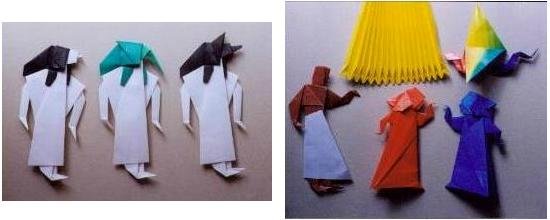
"Stone in Paper: Ancient Egypt" was an exhibit at the Origami USA 2002 convention in New York City. On display Friday, June 21 and Saturday, June 22, this exhibit comprised more than 80 original origami models in a triptych background. The left third held the tomb and the wild animal section; the middle third portrayed the Giza Plateau with pyramids and sphinxes; the right third contained the palace and the farm scene. Between plateau and palace was the Nile River, with a funerary barque, hippos and crocodiles. Four large hanging cartouches held hieroglyphs rendered in origami; on the wall of the tomb were four small cartouches with mini versions of the glyphs.
Due to circumstances beyond my control, I had to dismantle Ancient Egypt on Saturday afternoon to take home with me. I can find no other pictures of it on convention websites. Possibly very few people photographed it besides me and one of my dear club mates. Our photographs are here.
First photo: A view of the left half of the display. Nine heads of Hathor, the cow goddess, line the top edge of the tomb wall. (Photo by Kathryn Paulsen)
Second photo: The other half of the display. Along the top edge of the palace wall are alternating papyrus and lotus blossoms. (KP)
Third photo: A closer view of the middle section. Four mastabas, the Avenue of the Sphinxes, King Zoser's step pyramid, a tomb robber and camel in front of the Pryamid of Khufu, a scarab beetle, the Great Sphinx, a hippo and a crocodile. At the back, another pyramid and a camel caravan. (KP)
Fourth photo: A closer view of the tomb. Behind the upright tan mummy is the jackal-headed god Anubis; behind him is the ibis-headed god Thoth; behind him is the hawk-headed god Horus. Above them are a falcon and a vulture. Above the four canopic jars with lids depicting the four sons of Horus are the goddess Isis with vulture headdress and her brother/husband Osiris with crook and flail. (Photo by Anita F. Barbour)
Fifth photo: A closer view of the palace, with the pharaoh on his throne in the center below the rays of the sun god Aten. Nefertiti stands on the right, with dancing girls in white, green, red and blue. On the wall is the bust of Nefertiti; in the foreground is a duck-shaped basket filled with gold. (AFB)
Sixth photo: Another view of the sphinxes. (AFB)
Seventh photo: The farm scene, with cows eating hay from a trough, farmers, pigs and a goose. (AFB)
Other models in the display include the Royal Mother of the Kinhg's wife, a priest of Amun, a vulture carrying a shen ring which protects the pharaoh, two gold sarcophagi of King Tut, King Tut's gold mask, mummies, cat mummies, mummy casings, marsh duck, the Ba (one part of a human which separates from the body after death, depicted as a human-headed bird), the Ka (another part of a person which leaves the body after death, it's sort of like a ghost), ankh, cat, a box with five shawabtis (statuettes which do any work required of the deceased person in the afterlife), papyrus skiff with poler, three palm trees, lioness, lion, rhino, four giraffes and four more scarabs.
The hieroglyphs include sky, water, hand, foot, mouth, owl, vulture, horned viper, bread loaf, woman, quail chick, heron, and two reed leaves.
Back To Main Origami Page














